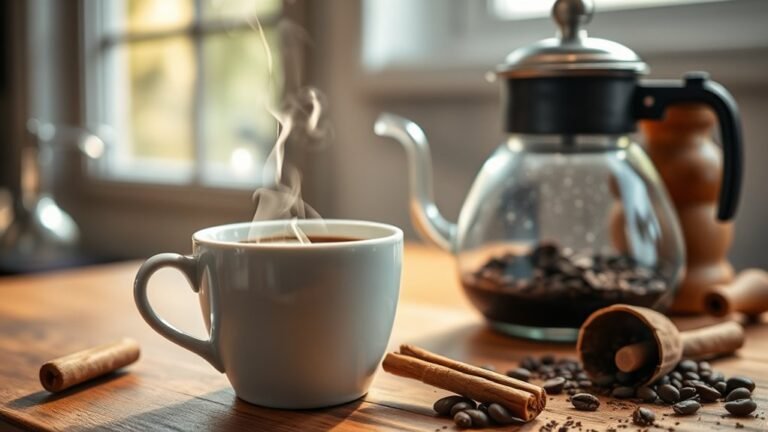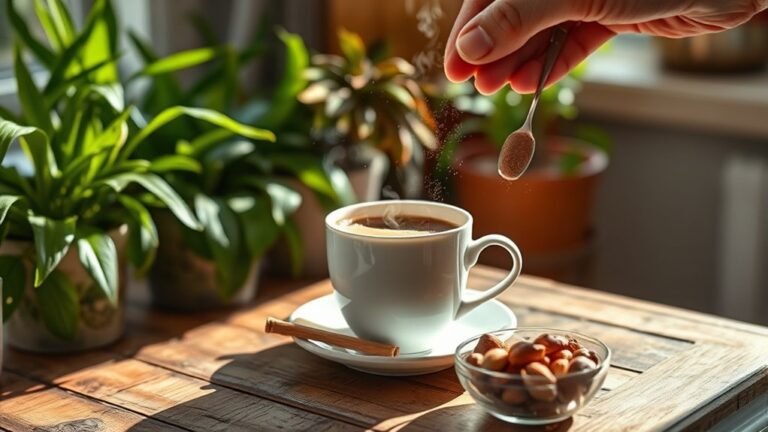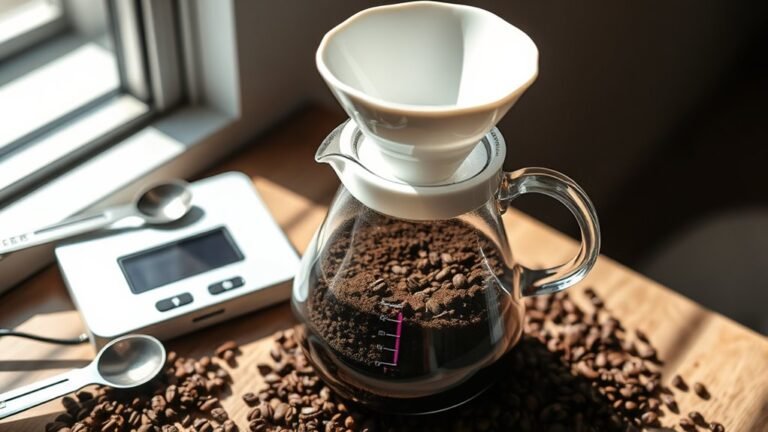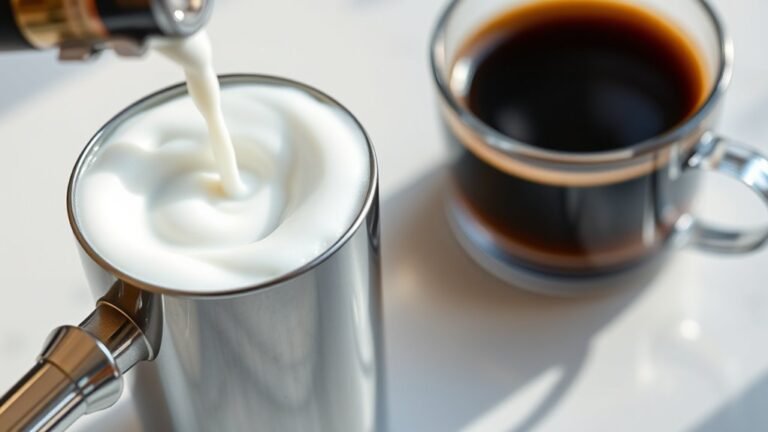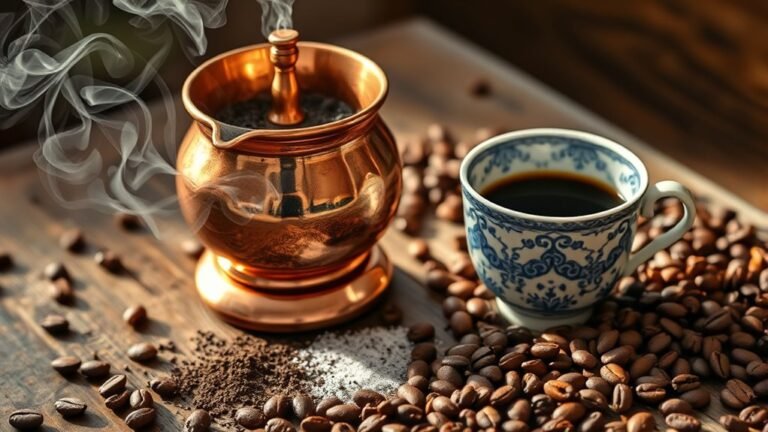The Perfect Extraction: A Guide to Under- and Over-Extraction
You’ll achieve the perfect extraction by balancing grind size, water temperature, and brew time to avoid sourness from under-extraction or bitterness from over-extraction. Under-extracted coffee tastes sharp and acidic, while over-extracted brews feel harsh and bitter. Precise control of your coffee-to-water ratio and consistent agitation guarantees even flavor development. Master these variables, and your coffee will deliver a rich, balanced profile every time. Explore how fine-tuning each factor transforms your brew.
Understanding Coffee Extraction
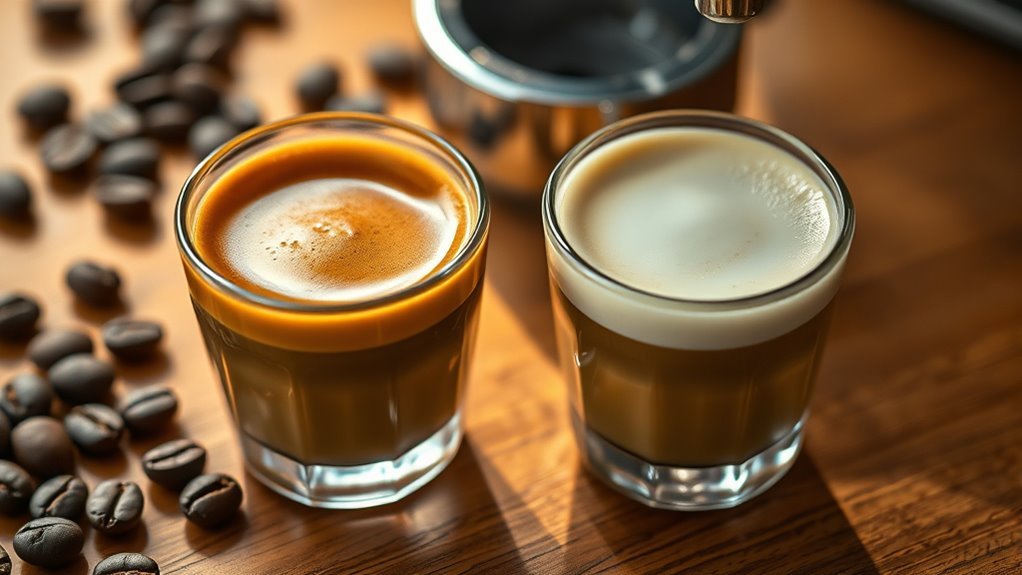
Extraction is the process where water dissolves soluble compounds from coffee grounds, directly influencing flavor and strength. When you control extraction chemistry, you dictate which flavor molecules are released and in what proportion, shaping your coffee’s taste profile. Early in extraction, acids and bright notes dissolve, followed by sugars contributing sweetness, then bitter compounds emerge if extraction continues too long. You’ll notice that balancing extraction chemistry is essential; under-extraction yields sour, weak coffee, while over-extraction produces bitterness and astringency. By mastering variables like grind size, water temperature, and contact time, you enable the freedom to craft coffee flavor exactly how you want it. Understanding this dynamic process empowers you to move beyond standard brewing and design your ideal cup with precision and expertise.
Signs of Under-Extraction
When your coffee tastes sharp or overly acidic, it’s a clear indication that the brew hasn’t fully developed its flavor compounds. This under-extraction occurs when water passes through the grounds too quickly or the grind size is too coarse, preventing the full spectrum of solubles from dissolving. You’ll notice a sour taste dominating your cup, a sign that the acidic compounds are extracted before the sweeter, balanced notes. Additionally, the aroma may feel weak, lacking the rich, intense fragrance you expect from a well-extracted coffee. These sensory cues suggest that the extraction time or water temperature might be insufficient. To gain access over your brew, adjust variables like grind size, dose, or contact time to guarantee a more complete extraction, releasing the coffee’s full potential and complexity.
Signs of Over-Extraction
If your coffee tastes bitter or overly harsh, it’s likely that too many compounds have been pulled from the grounds. Over-extraction occurs when extraction time is excessive or grind size is too fine, causing undesirable compounds like tannins and excessive caffeine to dominate. You’ll notice a pronounced bitter taste that overwhelms the nuanced flavors you seek. Additionally, the sensation of a dry mouth is common—this astringency signals that the coffee’s natural oils and sugars have been depleted. Your goal is to avoid this chemical imbalance by recognizing these sensory cues early. When your coffee feels harsh instead of smooth, you’re experiencing over-extraction, which strips away the freedom to enjoy a balanced, vibrant cup. Adjusting grind and timing can restore clarity and prevent this bitter outcome.
Factors Influencing Extraction
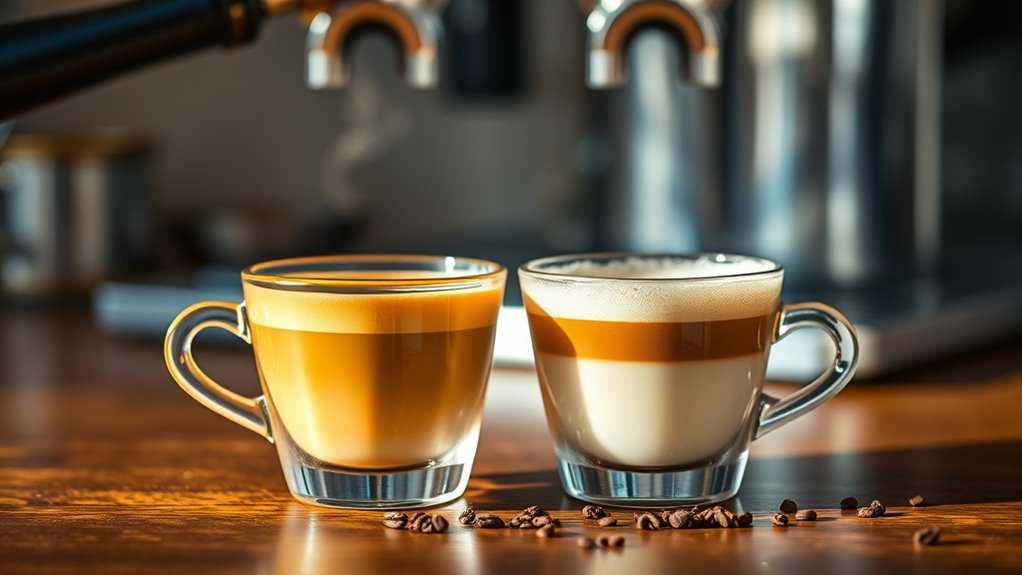
You’ll find that grind size directly controls the surface area exposed during extraction, affecting flavor balance. Water temperature influences solubility rates, altering the compounds drawn from the grounds. Brewing time then determines how thoroughly these compounds are extracted, so adjusting these variables carefully is key to mastering your brew.
Grind Size Impact
Although grind size might seem like a minor detail, it profoundly affects extraction by controlling the surface area exposed to water and the flow rate during brewing. You’ll notice that grind uniformity is essential; inconsistent particles cause uneven extraction, leading to bitter or sour notes. Precise grind adjustments let you fine-tune your brew, balancing flow and contact time to avoid under- or over-extraction.
| Grind Size | Effect on Extraction |
|---|---|
| Coarse | Faster flow, under-extraction |
| Medium | Balanced extraction |
| Fine | Slower flow, risk of over-extraction |
| Extremely Fine | Very slow flow, potential clogging |
Mastering these grind variables gives you complete control over your coffee’s flavor freedom.
Water Temperature Role
Water temperature acts as a critical catalyst in coffee extraction, directly influencing the solubility of flavor compounds and extraction efficiency. When you control water temperature precisely, you modulate how quickly acids, sugars, and bitter compounds dissolve. Too low, and your brew tastes sour and underdeveloped; too high, and it veers toward bitterness and astringency. Different brewing techniques demand distinct temperature ranges—espresso thrives around 90–96°C, while pour-over often benefits from slightly cooler water to highlight delicate notes. By mastering water temperature, you gain freedom to emphasize desired flavor profiles and avoid common extraction pitfalls. Your ability to adapt temperature based on grind size, roast level, and method empowers you to extract coffee’s fullest potential without overstepping into under- or over-extraction territory.
Brewing Time Effects
Since brewing time directly determines how long water interacts with coffee grounds, it plays a pivotal role in extraction quality. You’ll find that adjusting brewing time is a critical extraction variable across brewing methods—from quick espresso pulls to longer immersion techniques. Shorter times often under-extract, leaving your coffee sour and weak, while longer times risk over-extraction, causing bitterness and harshness. To gain access in dialing your extraction, start by mapping your method’s ideal brew window, then fine-tune within that range. Keep in mind, grind size interacts with time; coarser grounds require longer contact, finer grounds less. By mastering brewing time effects, you control flavor balance precisely, releasing the coffee’s full potential without sacrificing clarity or complexity. This control empowers you to craft coffee exactly as you desire.
Adjusting Grind Size for Better Extraction
When you adjust your grind size, you’re directly influencing how quickly water extracts flavors from the coffee grounds. A finer grind increases the surface area, accelerating extraction, while a coarser grind slows it down. Achieving ideal extraction demands precise control over grind consistency and particle uniformity. Uneven particles can cause channeling, resulting in under-extracted bitter or over-extracted sour notes. You want a grind size that balances extraction speed without compromising flavor clarity. Experiment with incremental adjustments, observing how small changes affect taste. Remember, your grinder’s calibration plays a pivotal role—high-quality burr grinders produce more uniform particles than blade grinders, granting you freedom to dial in your brew confidently. Mastering grind size empowers you to release the full potential of your coffee, achieving a balanced, nuanced cup every time.
Optimizing Brew Time and Temperature
Adjusting your grind size sets the stage, but dialing in brew time and temperature fine-tunes extraction to reveal your coffee’s full spectrum of flavors. Different brew methods demand specific timing—espresso thrives on rapid extraction, while pour-over benefits from a slower, controlled pour. Temperature control is equally essential; water that’s too hot can scorch your grounds, extracting bitter compounds, while too cool leaves underdeveloped, sour notes. Aim for a precise range, typically 195°F to 205°F, adjusting slightly based on your method and beans. Experiment with incremental changes in brew time and temperature to find your preferred balance, freeing yourself from rigid rules. Mastering these variables lets you reveal complexity and clarity, turning each cup into a tailored experience that reflects your taste and the coffee’s potential.
The Role of Coffee-to-Water Ratio
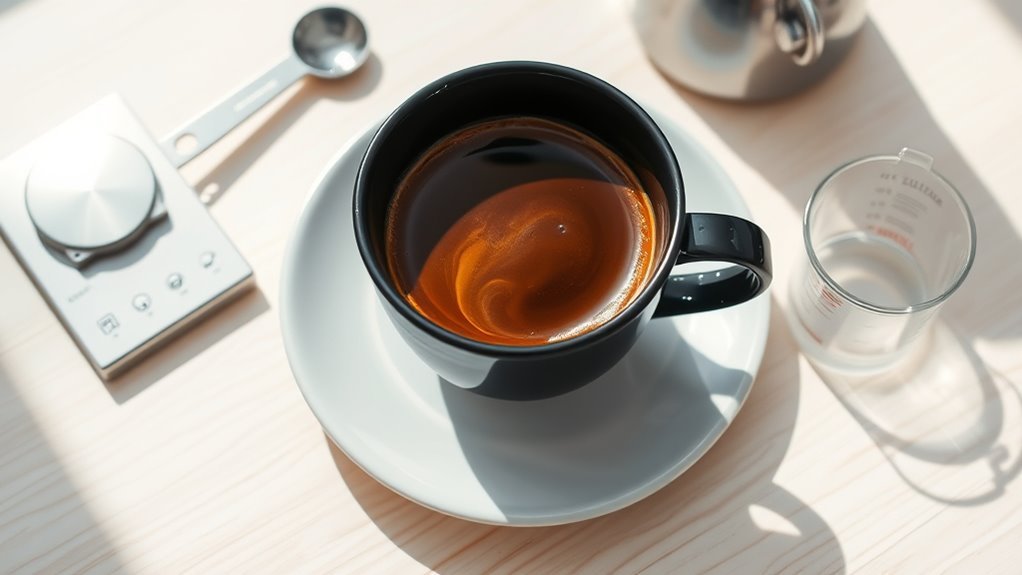
A carefully measured coffee-to-water ratio is fundamental to controlling extraction strength and flavor balance. When you adjust this ratio, you directly influence coffee strength, impacting how bold or mild your brew tastes. Different brewing methods demand specific ratios—for example, espresso typically uses a 1:2 coffee-to-water ratio, while pour-over might range from 1:15 to 1:17. By mastering these ratios, you gain freedom to tailor your cup precisely to your preferences. If your ratio skews too high, you risk over-extraction, resulting in bitterness; too low, and your coffee will taste weak and under-extracted. Understanding this balance lets you experiment confidently, optimizing strength without compromising flavor clarity. Essentially, the coffee-to-water ratio is your primary tool for revealing the full potential of your brewing method.
Tips for Consistent Extraction Results
Consistently achieving ideal extraction requires attention to several key factors that influence your brew’s balance. To maintain extraction consistency, refine your brewing techniques by controlling grind size, water temperature, and brew time precisely. Regularly calibrate your equipment to guarantee repeatability and monitor variables like agitation and coffee freshness. Mastery of these elements grants you freedom to experiment while securing reliable results.
| Factor | Tip for Consistency |
|---|---|
| Grind Size | Use a burr grinder; adjust in small increments |
| Water Temp | Maintain 195–205°F; use a thermometer |
| Brew Time | Time precisely; use a timer |
| Agitation | Stir gently and uniformly |
| Coffee Freshness | Use beans within 2 weeks of roasting |
Frequently Asked Questions
How Does Water Mineral Content Affect Coffee Extraction?
Imagine your coffee grounds as a garden thirsty for the right rain. If water hardness is too high, minerals act like stubborn stones, blocking flavors and causing under-extraction. Too soft, and the water can’t pull enough flavor, leading to over-extraction’s bitterness. To achieve extraction balance, you’ll want water with moderate mineral content—free enough to flow, yet rich enough to reveal your coffee’s true character. It’s about freedom in precision.
Can Different Coffee Beans Require Unique Extraction Adjustments?
Absolutely, you’ll find that different bean varieties demand unique extraction tweaks. Lighter roast levels often need longer contact time to reveal their nuanced flavors, while darker roasts extract faster but risk bitterness if overdone. Adjust grind size, water temperature, and brew duration based on the bean’s characteristics. Experimenting lets you tailor your process precisely, so you’re free to highlight each coffee’s distinct profile and craft the perfect cup every time.
What Impact Does Coffee Freshness Have on Extraction Quality?
Oh, because stale coffee just screams “best extraction,” right? Actually, freshness impact is huge—fresh beans have vibrant gases and oils that shape your flavor profile. When beans aren’t fresh, extraction struggles; your brew loses complexity and clarity. You want freedom to explore bold or subtle notes, but stale coffee limits that. So, keep beans fresh to release the full potential of your extraction, ensuring every cup’s a precise, flavorful experience.
How Do Espresso Machines Differ in Extraction Control?
Espresso machines differ primarily in how they manage pressure settings and temperature stability, which directly impact extraction control. When you dial in your machine, precise pressure settings allow you to adjust flow rate, influencing flavor balance. Temperature stability guarantees consistent water heat, preventing under- or over-extraction. Some machines give you full manual control, offering freedom to experiment, while others use automated profiles for consistency. Understanding these features lets you tailor each shot to your taste.
Is Pre-Infusion Necessary for Perfect Extraction?
Think of pre-infusion as gently waking your coffee grounds before the full pressure hits—this technique helps guarantee even saturation, reducing channeling and improving extraction consistency. While it’s not strictly necessary, incorporating pre-infusion benefits your espresso by allowing flavors to bloom gradually. Different pre-infusion techniques, like timed or pressure-controlled, give you freedom to tailor extraction, ultimately helping you avoid bitterness or sourness and craft a balanced, nuanced shot every time.


